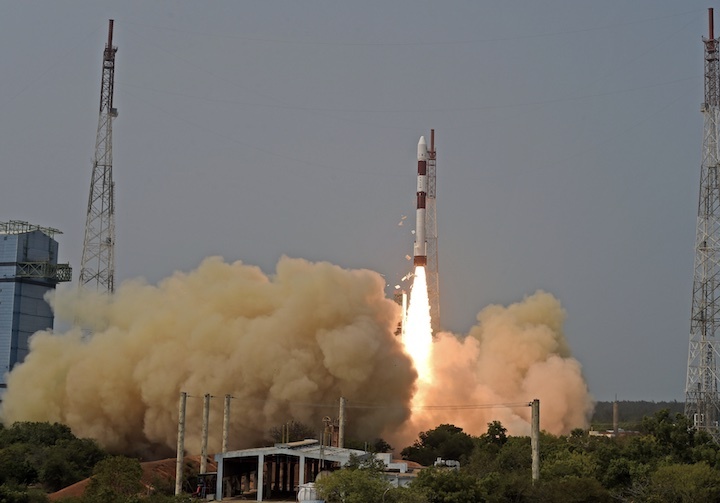21.04.2023
PSLV-C55 mission: ISRO to carry out in-orbit scientific experiments using spent PS4
This is the third time that PS4 will be used after satellite separation as a platform for experiments

The PSLV Orbital Experimental Module (POEM), which is part of the PSLV-C55 mission.
The PSLV-C55 mission has the PSLV Orbital Experimental Module (POEM), where the spent PS4 of the launch vehicle would be utilised as an orbital platform to carry out scientific experiments through non-separating payloads.
This is the third time that PS4 will be used after satellite separation as a platform for experiments.
According to the space agency, POEM has seven experimental non-separable payloads
- PiLOT (PSLV In orbitaL Obc and Thermals), a OBC package from Indian Institute of Space and Technology (IIST)
- ARIS-2 (Advanced Retarding Potential analyser for Ionospheric Studies) experiment from IIST
- HET-based ARKA200 Electric Propulsion System from Bellatrix
- DSOD-3U and DSOD-6U deployer units along with DSOL-Transceiver in S- & X- bands from Dhruva Space
- Starberry Sense Payload from Indian Institute of Astrophysics
The PSLV-C55 mission is a dedicated commercial mission through NSIL. TeLEOS-2 and Lumelite-4 satellites are intended to be launched into an eastward low inclination orbit.
ISRO said that the TeLEOS-2 satellite is developed under a partnership between DSTA (representing the government of Singapore) and ST Engineering. Once deployed and operational, it will be used to support the satellite imagery requirements of various agencies within the government of Singapore. TeLEOS-2 carries a Synthetic Aperture Radar (SAR) payload. TeLEOS-2 will be able to provide all-weather day and night coverage, and be capable of imaging at 1m full-polarimetric resolution.
Lumelite-4 satellite is co-developed by the Institute for Infocomm Research (I²R) of A*STAR and by the Satellite Technology and Research Centre (STAR) of the National University of Singapore. Lumelite-4 is an advanced 12U satellite developed for the technological demonstration of the high-performance space-borne VHF Data Exchange System (VDES). Using the VDES communication payload developed by I²R and STAR’s scalable satellite bus platform, Lumelite-4 aims to augment Singapore’s e-navigation maritime safety and benefit the global shipping community.
Quelle: The Hindu
----
Update: 22.04.2023
.
ISRO's PSLV-C55 lifts off with two Singaporean satellites, 7 Indian 'experiments' in textbook launch
- PSLV-C55 lifted off with two satellites from Singapore
- The primary payload was the TeLEOS-2, a Synthetic Aperture Radar
- The third big highlight of the mission is the PSLV Orbital Experimental Module
By India Today Science Desk: The Indian Space Research Organisation (ISRO) on Saturday launched two customer satellites in a textbook launch of the Polar Satellite Launch Vehicles. The 228-ton PSLV, on its 57th flight, lifted off from the Satish Dhawan Space in Sriharikota into an eastward low inclination orbit.
The two satellites belong to Singapore and combined weighed 757 kilograms. This was the third big launch of the year for the Indian space agency, which is in the midst of prepping for bigger missions going forward including the Chandrayaan-3 and the maiden solar mission, Aditya L-1.
Isro chief S Somnath, declaring the mission successful, said that PSLV placed both satellites in their intended orbit. "In its 57th mission, PSLV has demonstrated its higher reliability, and congratulations to the team and the NSIL for this mission," Somnath added.
What were the payloads onboard PSLV-C55?
The PSLV-C55 mission was launched with two satellites, with the primary one being the TeLEOS-2, a Synthetic Aperture Radar (SAR) payload, which will be able to provide all-weather day and night coverage, and capable of imaging at 1m full-polarimetric resolution.
Meanwhile, the second payload was developed for the technology demonstration of the High-Performance Space-borne VHF Data Exchange System (VDES). The 16-kilogram LUMELITE-4 is co-developed by the Institute for Infocomm Research (I2R) of A*STAR and the Satellite Technology and Research Centre (STAR) of the National University of Singapore.
The third big highlight of the mission is the PSLV Orbital Experimental Module, also called the POEM, which is a repurposed fourth stage of the rocket that normally ends as space debris. Isro has now developed it to be used as an experimental platform to conduct tests with non-separable payloads. The Poem carries seven such experimental payloads from Isro, Bellatrix, Dhruva Space, and the Indian Institute of Astrophysics. The payloads have an operational lifetime of 30 days in space.
The mission, which lasted for just about 20 minutes from launch to deployment of the two customer satellites, performed nominally on all stages. The three stages separated with precision and, on time, pushing the two satellites to the required altitude above the planet. The satellites were deployed at an altitude of over 600 kilometers above the planet.
Quelle: INDIA TODAY
+++
The PSLV-C55 mission launched with two satellites, with the primary one being the TeLEOS-2, a Synthetic Aperture Radar (SAR) payload.
PSLV- C55/TeLEOS-2 mission is accomplished successfully. In a textbook launch, the vehicle placed TeLEOS-2 and LUMELITE-4 satellites precisely into their intended 586 km circular orbit.




Quelle: ISRO
